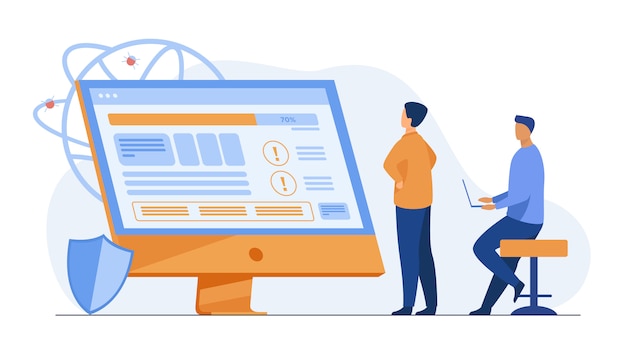Introduction: The Underrated Importance of Software Testing
Why Testing Matters in Interviews
Software Testing is a crucial phase in the development cycle that often doesn't get the attention it deserves, especially when preparing for interviews. However, this area is fertile ground for quick trivia questions that can catch you off guard during an interview.
Your Quick Cheat Sheet on Testing Terms
To help you navigate the waters, we've compiled a quick cheat sheet of the most popular terms in software testing. This guide aims to arm you with the essential knowledge you need to ace your next interview.

So, let's delve into the world of software testing and get you prepared for those unexpected questions that could come your way.
White Box vs. Black Box vs. Grey Box Testing: A Comprehensive Guide
The Battlefield of Testing Types
In the realm of software testing, there are primarily three warriors: White Box, Black Box, and Grey Box Testing. Each has its own set of armor, weapons, and battle techniques. The key difference? It all comes down to how much the tester knows about the internal workings of the software being tested.

White Box Testing: An Inside Look
Quick Summary
In White Box Testing, the tester is like an open book; they are fully aware of the internals of the item being tested.
Alternate Names
Also known as Internal Testing or Clear Box Testing.
Key Characteristics
- Knowledge Level: The tester knows the nitty-gritty details of how the code works and what its intended functionalities are.
- Rigorousness: This is a lower-level, more rigorous form of testing that dives deep into the codebase.
- Time Factor: Due to its thoroughness, White Box Testing is often time-consuming.
Real-world Examples
- Unit Testing: This involves testing your own code right after you write it to ensure it behaves as expected.
- Path Testing: This includes testing every if-else case in your code to ensure all paths execute correctly.
Black Box Testing: The Enigma
Quick Summary
In Black Box Testing, the tester is like a detective with a sealed envelope; they don't know the internals of what they're testing.
Alternate Names
Also referred to as External Testing or Closed Testing.
Key Characteristics
- Knowledge Level: The tester may know what the code is supposed to do, but they have no idea how it does it.
- Rigorousness: This is a higher-level, less rigorous form of testing.
- Time Factor: Black Box Testing is generally more time-efficient than White Box Testing.
Real-world Examples
- Functional Testing: This involves checking function outputs in response to a series of inputs.
- Non-Functional Testing: This covers general usability aspects like speed, security, and reliability.
Grey Box Testing: The Balanced Warrior
Quick Summary
Grey Box Testing is like a detective with a partially redacted file; they have some internal information but not all.
Alternate Names
Also known as Gray Box Testing.
Key Characteristics
- Knowledge Level: The tester has access to design specifications and documentation, such as UML and database diagrams.
- Tester-Developer Boundary: Grey Box Testing maintains a boundary between testers and developers, unlike White Box Testing.
- Code Access: Unlike White Box testing, the tester does not have access to the source code.
- Information Level: Compared to Black Box Testing, the tester has more insights into the item being tested.
Real-world Examples
- API Testing: When you test an API using its documentation to guide your tests.
- Design Requirement Testing: Ensuring the software meets its initial design requirements as laid out in the specification documents.
Functional Testing: Unpacking the Multiverse of Code Testing
The Testing Matrix
Functional Testing is the umbrella term that covers a plethora of tests conducted to ensure your code runs seamlessly. These tests range from scrutinizing individual components to making sure the entire system works like a well-oiled machine.

Unit Testing: The Microscope of Code Testing
Quick Summary
Unit Testing is like the microscope in a lab; it focuses on the smallest "unit" of code, usually a function or a module, to make sure it behaves as expected.
Alternate Names
Also referred to as Component Testing.
Key Characteristics
- Early Bug Detection: Identify and fix bugs early in the development cycle.
- Isolation: Units are isolated in their own environments to eliminate external dependencies.
- Manual or Automated: Can be executed manually or automatically using test frameworks.
- Types of Unit Testing: Unit testing can be white, black, or grey box.
Real-world Examples
- Assertion-based Testing: Using assertions to validate program state and behavior.
- Framework-based Testing: Using frameworks like JUnit to simulate test inputs and automate testing.
Integration Testing: The Compatibility Guru
Quick Summary
Integration Testing is the matchmaker of software testing. It ensures different units can work in harmony.
Alternate Names
Also known as Component or System Integration Testing.
Key Characteristics
- Unit Combination: Different units are combined and tested together.
Post-Unit Testing: Usually performed after unit testing.
Types of Integration Testing
- Component Integration Testing: Focuses on interactions between different components.
- System Integration Testing: Focuses on interactions between systems of components.
Real-world Examples
- Nested Component Testing: For example, making sure nested React components work well together.
- API Interaction: Testing your program's interaction with an API without any errors.
Regression Testing: The Time-Traveler
Quick Summary
Regression Testing ensures that your new time-traveling machine (new code changes) doesn't mess up the timeline (old code).
Key Characteristics
- Test Prioritization: Choose the most important tests to run as testing can be resource-intensive.
- Automation: Best if automated using tools like Selenium.
- Test Updates: Keep the test cases updated to reflect new code changes.
Real-world Examples
- Code Retesting: Running tests after incorporating new code changes.
- Development Branch Testing: Running tests after pulling new code from the development branch.
Smoke Testing: The Safety Net
Quick Summary
Smoke Testing is the fire drill of software testing; it ensures that the most critical functions of the software are operational.
Key Characteristics
- Basic Functionality: The core functions of the software must be in working condition.
- Quick and Efficient: Generally involves black box testing methods.
Real-world Examples
- Initial Test Run: The first series of tests conducted before diving into more intensive testing phases like Integration, Regression, and System testing.
System Testing: The Final Boss
Quick Summary
System Testing is the final boss level in a game; it tests if the whole system is up to snuff.
Key Characteristics
- Post-Integration Testing: Conducted after integration testing.
- Comprehensive: Involves a wide array of functional and non-functional tests.
Real-world Examples
- Smoke Testing
- Regression Testing
- Usability Testing
- Performance Testing
- Security Testing
Final Thoughts
Functional Testing is a complex universe with various galaxies like Unit, Integration, Regression, Smoke, and System Testing. Understanding each one in detail will prepare you for any curveballs in interviews and make you a more adept software engineer.
Let's test your knowledge. Is this statement true or false?
Unit testing can be both white box and black box testing, depending on how you implement the test cases.
Press true if you believe the statement is correct, or false otherwise.
Non-Functional Testing: The Unsung Hero of Software Quality
Introduction: Beyond Functionality
Non-Functional Testing is like the stage crew in a theatre production. While the actors (functionalities) get most of the attention, the stage crew ensures that the lighting, sound, and sets (performance, usability, security, etc.) are up to the mark.

Key Focus
Improving the code's performance, usability, and overall experience to meet or exceed customer expectations.
Acceptance Testing: The Audience's Applause
Quick Summary
Acceptance Testing is the final rehearsal where you ensure that the software will receive a standing ovation from its users.
Alternate Names
Also known as User Acceptance Testing (UAT).
Key Characteristics
- End-Stage Testing: Conducted at the end of the software lifecycle in sequential models like Waterfall and at the end of each iteration in Agile.
- Black Box Approach: The focus is on the output, not the internal code structure.
Real-world Examples
- Alpha Testing: An internal company trial of an unreleased video game.
- Beta Testing: Releasing the game to a select group of external users, like popular streamers, to gather feedback.
Usability Testing: The Director's Cut
Quick Summary
Usability Testing ensures that using your software is as intuitive as navigating a well-directed movie.
Alternate Names
Also known as User Experience or UX Testing.
Key Characteristics
- Efficiency Focus: Streamline frequently used features.
- Error Detection: Identify misunderstandings or operational errors by users.
- Black Box Approach: Focuses on user interaction rather than code.
Real-world Examples
- User Observation: Watching a user navigate through a series of tasks in your software and taking note of any difficulties or misunderstandings.
Performance Testing: The Choreographer's Precision
Quick Summary
Performance Testing fine-tunes the software's speed and stability, much like a choreographer ensures every dance move is executed flawlessly.
Alternate Names
Also known as Responsiveness or Stability Testing.
Key Characteristics
- Bottleneck Identification: Locate and optimize system bottlenecks.
- Workload Management: Monitor how the system performs under varying workloads.
Real-world Examples
- Stress Testing: Overloading an e-commerce website to identify its breaking point.
- Endurance Testing: Continuous testing to ensure long-term system stability.
- Spike Testing: Simulating abrupt workload increases to test system adaptability.
Security Testing: The Bodyguard's Vigilance
Quick Summary
Security Testing is the bodyguard that spots and neutralizes vulnerabilities before they can harm your software.
Alternate Names
Also known as Vulnerability Testing.
Key Characteristics
- User Trust: Establish a secure environment to build user trust.
- Holistic Security: Examine network, client-side, and server-side security measures.
Real-world Examples
- Network Security: Assessing network policies and data transfers.
- System Security: Examining software dependencies for vulnerabilities.
- Client-Side Security: Ensuring the client or browser is secure against manipulations.
- Server-Side Security: Making sure the back-end server can withstand intrusion attempts.
Non-Functional Testing is an indispensable part of ensuring that your software is not just functional, but also efficient, user-friendly, and secure. Paying attention to these aspects can make your software go from good to great.
Try this exercise. Click the correct answer from the options.
Which type of testing should be used in case of an interface error?
Click the option that best answers the question.
- White box testing
- Unit testing
- Integration testing
- Performance testing
Test-Driven Development in the Agile World: A Symphony of Iterations and Tests
The Harmony of Agile and Testing
Test-Driven Development (TDD) and Agile are like two instruments in an orchestra, each playing its part to create a harmonious software development process. In Agile, the focus is on iterative development and client feedback, while TDD ensures that each iteration is up to the mark by setting tests as the foundational blocks.

Agile Development: The Iterative Maestro
Key Characteristics
- Iterative Lifecycle: Agile is like a composer working in iterations, constantly revising and improving the score.
- Client-Centric: Highly flexible and oriented towards meeting client requirements and feedback.
- Frequent Testing: After each iteration of the product, testing is performed. This is akin to a musician continually tuning their instrument.
- Continuous Feedback Loop: Constant feedback is utilized to make adjustments and improve the software.
Agile Testing: The Improvisational Soloist
Key Characteristics
- Ad-hoc Planning: Think of it as a jazz musician improvising a solo. Tests are planned on the fly, and processes are less structured.
- Dynamic Test Cases: As the demands of the composition (software) change, the musician (tester) changes their notes (test cases) accordingly.
- Functional Focus: The spotlight is on creating software that works efficiently, much like a musician focuses on hitting the right notes to maintain the melody.
Agile Development and Agile Testing in the context of Test-Driven Development are like a well-coordinated orchestra. They each bring unique strengths to the table—Agile keeps the client in focus with its iterative cycles, and TDD ensures that each of those cycles produces a quality output. Understanding this harmony can help you navigate the complexities of modern software development.
Try this exercise. Fill in the missing part by typing it in.
Testing if a landing page of a website loads within few seconds is an example of ___ testing.
Write the missing line below.
Testing: Your Interview Cheat Sheet
Introduction: The Unseen Hero of Software Development
While software testing may not be the star of the development process, it's a critical component that ensures the quality of the final product. Consider this your go-to cheat sheet for testing-related interview questions.

Your Toolbox: Libraries for Testing
Quick Summary
Discuss the testing libraries you've used and your experiences with them.
Popular Choices
- Python:
- pytest
- unittest
- Java:
- JUnit
- TestNG
- JavaScript:
- MochaJS
- Jest
- Jasmine
- Others:
- Selenium
- Cucumber
- Capybara
Personal Experience Example
"I automated tests for an e-commerce application using Selenium WebDriver in Java."
Four Pillars: Main Levels of Testing
Quick Summary
List the 4 primary levels of testing.
The Big Four
- Unit Testing
- Integration Testing
- System Testing
- Acceptance Testing
Note: Regression Testing can be applied between any of these levels.
Crafting Quality: Key Elements of Good Test Cases
Quick Summary
Discuss what makes a test case effective and reliable.
Essential Elements
- Simplicity: Aim for clarity. Your future self and colleagues will thank you.
- Maximum Coverage: Optimize test cases to maximize the likelihood of identifying defects.
- Repeatability: Ensure consistent results across different testing environments.
Testing vs Verification: The Key Distinctions
Quick Summary
Understand the difference between software testing and software verification.
Key Differences
- Software Testing: Validates if the software meets user needs through test cases.
- Software Verification: Formally proves software against its specification, which is much more rigorous.
The Pen Test: Evaluating a Retractable Ballpoint Pen
Quick Summary
Be specific and creative in your approach to testing an everyday object like a pen.
Testing Types and Scenarios
- Unit Testing:
- Check for ink leaks.
- Assess pen body durability.
- Smoke Testing:
- Can the pen write?
- Integration Testing:
- Do all components fit and function together?
- Regression Testing:
- Does a new spring mechanism affect the pen's retraction?
- Acceptance Testing:
- Is the pen comfortable to use?
- Usability Testing:
- Can users easily operate the pen's retractable feature?
Light Bulb Riddle: The Tester's Dilemma
Quick Summary
Answer the humorous question, "How many testers does it take to change a light bulb?"
Light-hearted Answer
None. Testers identify problems; they don't fix them.
Final Thoughts
This cheat sheet is designed to prepare you for questions that explore the depth of your understanding in software testing. While many of these questions are open-ended, coming up with your own well-thought-out answers will not only impress your interviewers but also deepen your understanding of the subject matter.
Are you sure you're getting this? Click the correct answer from the options.
Which kind of testing does not require you to design test cases?
Click the option that best answers the question.
- Black box testing
- Usability testing
- Unit testing
- Smoke testing
One Pager Cheat Sheet
- Software Testing is an essential knowledge for any software position, often overlooked in interviews, but
fair gameas trivia questions. - White Box and Black Box testing differ in terms of
visibility of the internal designwith the former being more rigorous and time consuming, while the latter is higher level and time efficient. Grey Box testing is a combination of the two. - Functional testing, integration testing, regression testing, smoke testing, and system testing are all necessary steps to ensure that software runs as expected without any bugs.
- Unit testing is a process of validating the expected behvaiour and logic of a
unitof code using both white box and black box methods, which involve inspecting theinternal structureandinput/outputrespectively. - Non-Functional Testing is used to ensure the software will be received well by users/consumers, is intuitive and easy to use, and is secure, fast, and stable.
- Integration Testing is a type of testing which tests the interactions between different systems or
applicationsto ensure correct and accurate communication. Test Driven Development(TDD) is an agile, iterative process of software development with a focus on ensuring software that works, where tests are planned and executed on the fly, and frequent feedback is provided for improving the product.- Testing non-functional attributes such as performance, security, usability, and maintainability aims to assess the behavior of the system, rather than its functionality, with examples such as testing page load speed.
- For software validation, various
testinglevels, such asUnit,Integration,SystemandAcceptanceTesting, involve designing test cases for maximum coverage and repeatability to ensure the software meets the users' needs. - Smoke Testing is a
non-exhaustivetest used as a"quick check"to provide a higher-level overview of an application's condition and identify any major issues.


